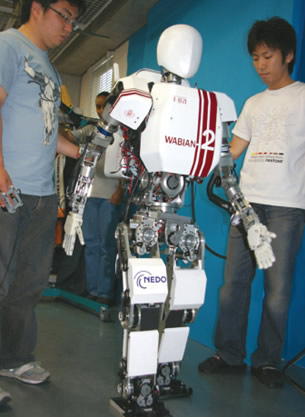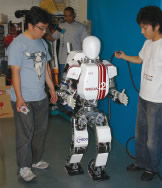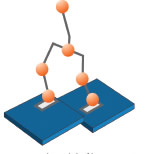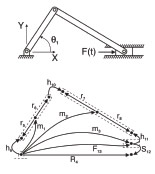Modeling the New Mathematics
Japanese research into robotics leads the way to physical modeling and genuine innovation.
Latest News
January 6, 2008
By Tom Lee
 WABIAN, a humanoid robot designed by the Takanishi Laboratory of Waseda University in Tokyo, Japan, assists in anthropomorphic robotics research, and emulates human motion and behavior. |
Over the past half century, Japanese research and industry have amazed the world with innovative and often outrageous technological feats. Manufacturing techniques for unprecedented levels of quality and ongoing miniaturization of personal electronics are only two examples of how Japan has changed our world. Even if Canon were to announce that it’s put an entire video production facility on a device the size of a credit card, or if Honda managed to integrate airbags, dual drink holders, and HDTV on a motorcycle that can travel 200 mph on a couple of AA batteries (rechargeable, of course), I don’t think most of us would be surprised — it all seems so “old hat” now.
Recently, Japan has started flexing its creative muscle once again and is poised to surprise and impress the heck out of the rest of the world. One of the most intriguing new waves in Japanese technology research is in the field of humanoid robots. (When we were kids, robots meant C-3PO from Star Wars or Robbie the Robot from Forbidden Planet.) With the aid of some new mathematical techniques and some powerful new computing tools, scientists and engineers have started to realize a part of this science-fiction dream.
Many of us have seen footage of Honda’s Asimo robot and its ability to walk and move in a very human way. Arguably lesser known outside of Japan, but considerably more innovative in many ways, is the work of the Takanishi Laboratory of Waseda University in Tokyo. Dr. Atsuo Takanishi is a leading researcher in the area of humanoid robotics. Unlike the industrial robots that most engineers are typically familiar with, humanoid robotics research aims to emulate human motion and even behavior to result in anthropomorphic robots.
Introducing Wabian
 To achieve gait patterns, natural rhythms, and stability on various surfaces, new techniques model and simulate such biomechanics. |
Professor Takanishi’s achievements include the WABIAN series of robots (short for WAseda BIpedal humANoid), noted for its ability to walk in a very human-like way. The Takanishi Lab’s website offers a range of photos and videos of WABIAN and its kin. In order to achieve the correct gait patterns, natural rhythms, and maintain stability on various walking surfaces, the lab’s scientists have developed sophisticated techniques to model and simulate the biomechanics prior to commitment in a physical robot.
According to research papers, an adequate model of WABIAN requires a minimum eight degrees of freedom (DOF). This means the model must take into account eight independent spatial frames of reference to express the math needed to capture sufficient motion subtlety. Typically, the actual number of simultaneous model equations that result from real-world mechanisms operating in 3D space can be significantly higher than the number of DOF. These equations would typically be coupled differential equations and differential algebraic equations (DAE) that would ultimately be a challenge for any modern solver. In essence, there are two major technical challenges: derivation of the model mathematics and the solution of the model equations themselves.
Professor Takanishi has developed a series of specialized techniques to derive and solve these equations — an approach that would literally take months to work out the mathematics in order to ensure all of the geometric and physical continuities. Historically, advanced modeling such as these cases demanded specialized attention and human-intensive steps. More recently, however, techniques and tools have emerged to provide a systematic framework for dealing with such complexity.
 Here is a conceptual model of human gait. |
This type of modeling and simulation is pretty ambitious stuff, and it has only been the convergence of several major techniques that have made this feasible: symbolic computation, numerical solvers, and automatic model generation techniques.
The first two should be familiar to most engineers. Symbolic computations, as represented by popular systems like Maple, allow manipulation of huge amounts of mathematical expressions as mathematics and not just numbers: they can solve analytically, compute symbolic derivatives, and generally apply the rules of mathematics in an efficient and error-free way. Advances in numerical computation such as differential algebraic equations — DAE (more complicated and harder-to- solve cousins of differential equations) — have made efficient solution of simulation models feasible. Finally, theoretical frameworks such as linear graph theory offer a robust methodology to systematically describe the system, have symbolic technology automatically create model equations, and then have the DAE solvers produce the desired results.
The results of this advanced modeling are pretty impressive. The Takanishi robots not only walk, but they smile, can carry a heavy load up a set of stairs, and even “breathe,” or more precisely, emulate the mechanics of breathing. Why go through all of this trouble? Why would we want to have machines so closely emulating human behavior?
Often the answers from the researchers are vague and indeterminate. Comments range from a desire for pure scientific research to the belief that people will want mechanical replicas of themselves for service and even companionship. But overall, there does not seem to be a general rationale or motivation for this and, in some sense, this may be one of the strengths of Japanese research.
Our competition
Japan has a strong record of promoting and financially supporting innovation and pure technology research at both the governmental and industrial levels. Issues such as ROI and immediate feasibility are often pushed aside. Developing pure state- of-the-art technology is the primary motivation. Indeed, the current trend in Japan of deploying more advanced mathematical models in engineering design is a reflection of Japanese industry’s willingness to step beyond the conventional tool chain.
 Here is a representation of a mechanical system using linear graph theory. |
Recently, Toyota and Maplesoft (makers of the Maple math software package) announced a comprehensive initiative to develop and implement new-generation modeling technologies in the design of Toyota vehicles. Dr. Akira Ohata, project general manager of Toyota Motor Corporation, states in a Maplesoft press release, “Symbolic computation makes new design methods a reality today. Automotive companies like us will realize further improvements in cycle times, cost optimization, and smoother implementation of extremely complex systems.”
The technology and inherent modeling techniques that Ohata refers to deploy techniques and mathematics that are strongly related. He calls this new modeling technique “physical modeling,” referring to the technique’s ability to more intuitively connect to the physics concept in a design. In many ways, physical modeling can help make a robot laugh, but will also help your Toyota vehicle get better fuel mileage in the future.
The fact that Japan has made huge strides in modeling humanoid robots is not really the issue. The main issue is that our competitors are creatively exploring new design techniques that may seem almost frivolous (in its context), but in reality, bring a powerful new technique to the modern engineer. Today, we seem obsessed with the potential threat of hundreds of thousands of engineers and scientists emerging from China and India. Before we obsess over that competitive threat, we should remember our traditional competition, Japan. Our colleagues in Japan have taught us a lot over the past half century. This is one more opportunity for us to critically assess our current methods and seriously explore new techniques and tools. The price we pay may simply be to watch a few more Star Trek episodes for inspiration.
More Information
Maplesoft
Maple
Waterloo, Ontario
maplesoft.com
Takanishi Laboratory
Waseda University
Tokyo, Japan
takanishi.mech.waseda.ac.jp/
Tom Lee, vice president of market development at Maplesoft, is the host of Maplesoft’s podcast series, MapleCast. He is chief editor of MaplePrimes. com, which is a blog and forum for mathematical software. You can send e-mail about this topic to [email protected].
Subscribe to our FREE magazine, FREE email newsletters or both!
Latest News
About the Author
DE’s editors contribute news and new product announcements to Digital Engineering.
Press releases may be sent to them via [email protected].






